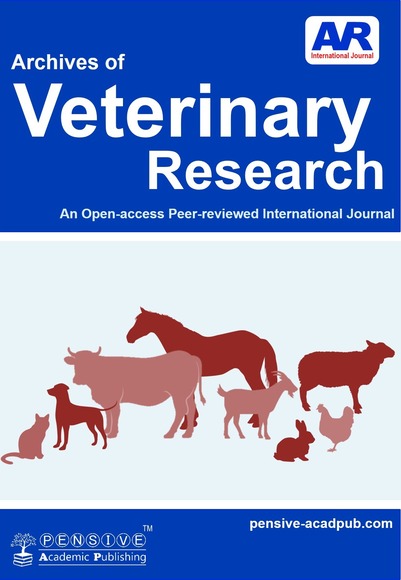Genetic characterization and phylogenetic analysis of Peste des Petits Ruminants virus (PPRV) from an outbreak in Puducherry region, India
Genotyping of PPR virus in India
DOI:
https://doi.org/10.70964/avr.7Keywords:
Peste des Petits Ruminants, RT-PCR, N gene, Sequencing, Phylogenetic analysisAbstract
Peste des petits ruminants (Goat plague) is an acute, highly contagious, and lethal viral disease of goats and sheep. It causes high morbidity and mortality and is considered a significant constraint on the productivity of small ruminants. Four genetic lineages of the PPR virus (Genotype I to IV) have been identified globally. The study was planned to genetically characterize the circulating PPR virus lineages/genotypes in a suspected outbreak in goats from the Puducherry region (Southern India). Fifty-nine nasal/faecal swabs were collected from the goats with the history of profuse diarrhoea, nasal and ocular discharges, stomatitis, and high mortality during the outbreak. A total of 44 out of 59 (74.5%) nasal/faecal swabs were found positive by Reverse Transcriptase PCR targeting the N gene of the PPR virus, with an amplicon size of 359 bp. Based on sequence analysis of three representative samples, the Indian vaccine strain and various global genotypes, forty-one non-synonymous amino acid variations were identified from 110 amino acids. These amino acid variations specific to the study sequences are characteristic of the Genotype IV lineage. Though the vaccine virus (Sungri 96 strain) also had amino acid relatedness with the Genotype IV lineage, nine non-synonymous mutations were repeatedly identified in the field strains, indicating that the virus is under serious positive selection in these regions. In addition, three new mutations were identified at the positions Lys/Gln458→Pro, Thr469→Pro, and Met507→Thr of the N gene. Thus, it could be concluded that the genotype IV lineage of PPRV is circulating in India with three new mutations at the N gene. As the PPRV strains were found to be under immense selection pressure and realizing the constant mutations happening in the field strains, monitoring of circulating genotypes in wider geographical regions of India would be of utmost importance.
References
1. Dhar P, et al. Recent epidemiology of peste des petits ruminants virus (PPRV). Vet Microbiol. 2002; 88(2):153-9. https://doi.org/10.1016/S0378-1135(02)00102-5
2. Roeder P, et al. Recognizing peste des petits ruminants: a field manual. FAO animal health manual, vol. 5; 1999. p. 28.
3. Taylor W. The distribution and epidemiology of peste des petits ruminants. Preventive Veterinary Medicine. 1984; 2(1):157-66. https://doi.org/10.1016/0167-5877(84)90059-X
4. Balamurugan V, et al. Seroprevalence of Peste des petits ruminants in cattle and buffaloes from southern peninsular India. Trop Anim Health Prod. 2012; 44(2):301-6. https://doi.org/10.1007/s11250-011-0020-1
5. Abraham G, et al. Antibody seroprevalences against peste des petits ruminants (PPR) virus in camels, cattle, goats and sheep in Ethiopia. Preventive veterinary medicine. 2005; 70 (1): 51-7. https://doi.org/10.1016/j.prevetmed.2005.02.011
6. George, A.A. (2002). Comparative evaluation of different gene targets for PCR diagnosis of PPR. M.V.Sc. thesis, Deemed University IVRI, Izatnagar, India
7. Banyard AC, et al. Global distribution of peste des petits ruminants virus and prospects for improved diagnosis and control. J Gen Virol. 2010; 91 (12): 2885-97. https://doi.org/10.1099/vir.0.025841-0
8. Kwiatek O, et al. Peste des petits ruminants (PPR) outbreak in Tajikistan. J Comp Pathol. 2007; 136 (2):111-9. https://doi.org/10.1016/j.jcpa.2006.12.002
9. Senthilkumar K., AravindBabu, Sundarapandian G., Parimal Roy., Thangavel A., & Sivakumar K. (2014). Molecular characterization of lineage IV Peste Des Petits Ruminants Virus using multi gene sequence data. Veterinary Microbiology. 174, 39-49. https://doi.org/10.1016/j.vetmic.2014.08.031
10. Shaila M, et al. Geographic distribution and epidemiology of peste des petits ruminants viruses. Virus Res. 1996; 43(2):149-53. https://doi.org/10.1016/0168-1702(96)01312-3
11. Wang Z, et al. Peste des petits ruminants virus in Tibet, China. Emerg Infect Dis. 2009; 15 (2): 299. https://doi.org/10.3201/eid1502.080817
12. Baron MD, et al. Future research to underpin successful peste des petits ruminants virus (PPRV) eradication. J Gen Virol. 2017; 98 (11): 2635-44. https://doi.org/10.1099/jgv.0.000944
13. Baazizi R, et al. Peste des petits ruminants (PPR): a neglected tropical disease in Maghreb region of North Africa and its threat to Europe. PLoS One. 2017; 12(4):e0175461. https://doi.org/10.1371/journal.pone.0175461
14. Clarke, B.D., Islam, M.R., Yusuf, M.A., Mahapatra, M., Parida, S., 2018. Molecular detection, isolation and characterization of Peste-des-petits ruminants virus from goat milk from outbreaks in Bangladesh and its implication for eradication strategy. Transbound. Emerg. Dis. 65, 1597-1604. https://doi.org/10.1111/tbed.12911
15. Dundon, W.G., Diallo, A., Cattoli, G., 2020. Peste des petits ruminants in Africa: a review of currently available molecular epidemiological data, 2020. Arch. Virol. 165, 2147-2163. https://doi.org/10.1007/s00705-020-04732-1
16. Balamurugan V, Hemadri D, Gajendragad MR, Singh RK, Rahman H (2014a). Diagnosis and control of peste des petits ruminants: a comprehensive review. Virus Dis. 25(1): 39-56. https://doi.org/10.1007/s13337-013-0188-2
17. Munir, M., Zohari, S., Saeed, A., Khan, Q., Abubakar, M., LeBlanc, N. and Berg, M., 2012. Detection and phylogenetic analysis of peste des petits ruminants virus isolated from outbreaks in Punjab, Pakistan. Transbound. Emerg. Dis., 59: 85-93. https://doi.org/10.1111/j.1865-1682.2011.01245.x
18. Tamura K, Stecher G, Kumar S (2021) MEGA11: Molecular Evolutionary Genetics Analysis Version 11. Mol Biol Evol 38: 3022-3027 https://doi.org/10.1093/molbev/msab120
19. Kumar, S.S., Babu A., Sundarapandian G., Roy P., Thangavelu A., Kumar K.S., Arumugam R., Chandran N.D.J., Muniraju M., Mahapatra M., Banyard A.C., Manohar B.M. and Parida, S., 2014. Molecular characterisation of lineage IV peste des petits ruminants virus using multi gene sequence dD. Vet. Microbiol., 174: 39-49. https://doi.org/10.1016/j.vetmic.2014.08.031
20. Kgotlele, T., Macha1, E.S., Kasanga, C.J., Kusiluka, L.J.M., Karimuribo, E.D., Doorsselaere, V.J., Wensman, J.J., Munir, M., & Misinzo, G. (2014). Partial genetic characterization of peste des petits ruminants virus from goats in Northern and Eastern Tanzania. Blackwell Verlag GmbH, 61(1), 56-62 https://doi.org/10.1111/tbed.12229
21. Couacy-Hymann, E., Roger, F., Hurard, C., Guillou, J. P., Libeau, G., & Diallo, A. (2008). Rapid and sensitive detection of Peste des Petits Ruminants virus by a polymerase chain reaction assay. Journal of Virology Methods, 100, 17-25 https://doi.org/10.1016/S0166-0934(01)00386-X
22. Bao J, Wang Q, Li L, Liu C, Zhang Z, Li J, Wang S, Wu X, Wang Z. Evolutionary dynamics of recent peste des petits ruminants virus epidemic in China during 2013-2014. Virology. 2017 Oct;510:156-164. doi: 10.1016/j.virol.2017.07.018. Epub 2017 Jul 19. https://doi.org/10.1016/j.virol.2017.07.018
23. Parida, S., Muniraju, M., Altan, E., Baazizi, R., Raj, G.D., & Mahapatra, M. (2016). Emergence of PPR and its threat to Europe. Small Ruminant Research, 142, 16-21. https://doi.org/10.1016/j.smallrumres.2016.02.018
24. Muthuchelvan D, De A, Debnath B, Choudhary D, Venkatesan G, Rajak KK, Sudhakar SB, Himadri D, Pandey AB, Parida S (2014). Molecular characterization of peste-des-petits ruminants virus (PPRV) isolated from an outbreak in the Indo-Bangladesh border of Tripura state of North-East India. Vet. Microbiol. 174(3-4): 591-595. https://doi.org/10.1016/j.vetmic.2014.10.027
Downloads
Published
How to Cite
Issue
Section
License
Copyright (c) 2024 © 2024 Pensive Academic Publishing. All rights reserved. | Archives of Veterinary Research

This work is licensed under a Creative Commons Attribution 4.0 International License.




